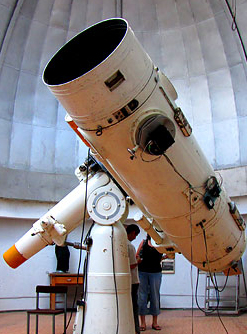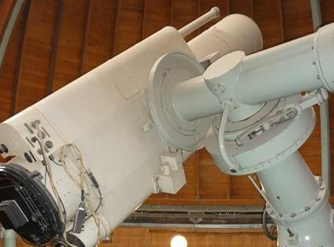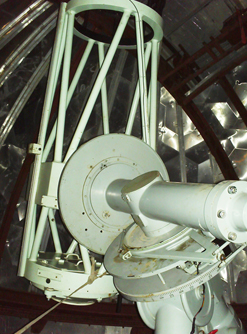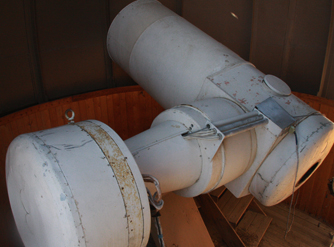Astronomy in Tajikistan – Institute of Astrophysics
tel. (+992 37) 227-46-14, Email: This email address is being protected from spambots. You need JavaScript enabled to view it.
The modern astronomy sciences in Tajikistan started from the Tajik Astronomical Observatory (TAO), established in November 13, 1932 by the government of Tajik Soviet Socialistic Republic. Stalinabad Astronomical Observatory, SAO, started in 1948 by the resolution of the Communist Party and Council of Ministers of the Tajik SSR of January 17, 1958 was transformed into Institute of Astrophysics of Tajik Academy of Sciences of the USSR.
Over the years, the Institute is headed by academician P.B. Babadzhanov (1959-1971, 1992-2002), O.V. Dobrowolskiy (1971-1977), corresponding member M.N. Maksumov (1977-1992), corresponding member Kh.I. Ibadinov (2003 to present).
The Institute started research on natural and man-made space objects through international projects and programs. Fundamental researches were conducted on meteors and Earth’s upper Atmosphere, comets and asteroids, stars and galaxies. Under the leadership of academicians O.V. Babadzhanov and Dobrowolskiy, the well-known scientific schools on meteoritic matter and the physics of comets was established. The Institute was awarded the Order of Labor Red Banner in 1969.
The International Astronomical Union (IAU) praised the contributions of the institute in astronomical science, assigning nine minor planets by names “Tajikistan”, “GISAO” and the names of seven scientists of the institute.
Now at the Institute of Astrophysics there are three astronomical observatories at different altitudes from the sea level: Hissar Observatory (HisAO, altitude 730m), the observatory “Sanglokh” (height 2300m) in Dangara area and its branch, the observatory “Pamir” (height 4350m) in Murghab district of Badakhshan. The Institute consists of Department of comets and asteroids with a group of experimental astrophysics, department of meteor astronomy, ionospheric, a group of astrometry, a group of variable stars and the group of structure and dynamics of stellar systems.
During the years of independence of the Republic of Tajikistan, the Institute of Astrophysics retained the basic scientific potential, astronomical observatories and major equipment, continued basic and applied research of comets, meteoric matter, and natural and near earth objects, variable stars, star systems, galaxies and seismoionosferic effects.
The Institute has started rebuilding and modernizing its astronomical observatories and have installed and commissioned a 60cm reflector (Carl Zeiss in the observatory “Sanglokh”). In 2007, introduction of new equipment (i.e. charge system) and computer technology astrophysical observations of cosmic objects were started. This has enabled the institution to participate successfully in the projects of the International Science and Technology Center, in the International Programme PULKON, in the projects of the International Year of Astronomy, UNESCO and the UN. The active cooperation of the institute with the Institute of International Astronomical Union. In 1993, Tajikistan became a member of the Union with the International Committee on Space Research (COSPAR). In addition, projects with the Euro-Asian Astronomical Society and other International scientific organizations were restarted.
The Institute has strengthened cooperation with foreign research institutions and organizations. Agreements on scientific - technical cooperation with M.V. Lomonosov Moscow State University, with Institute of Applied Mathematics of Russian Academy of Sciences, Main Astronomical Observatory of National Academy of Sciences of Ukraine, Astronomical Observatory of Kiev National University, Uranskop of France were signed on the request of the International Astronomical Society to the astronomical observatory “Sanglokh”. The institute was given the status of an international astronomical observatory with branch in the Pamirs. Scientists from Russia, Ukraine and France are working together with Tajik scientists in the observatories, whereas young employees improve their skills in astronomical observatories in these countries. The collaboration is strengthened with national research institutions and universities.

Telescope AZT-8 GissAO

Gissar astronomical observatory (GissAO) 40-cm astrograph.

Astronomic observatory “Sanglokh” 60-cm reflector “Carl Zeiss”

Astronomic observatory “Pamir” 70-cm telescope
During the study of small bodies in the Solar System – comets, asteroids and meteoric matter, the regularities of the evolution of short periodic comets to asteroid like bodies, the regularities of development of active processes in the cemetery nuclei, the decay of registered short periodic comet 17 / Holmes and conditions of the decay of a nucleus of a comet are clarified. The conditions for the eruption of a large anomalous dust tail of comets from the nucleus of a dozen comets are clarified. The regularities of the destruction of the comet’s nucleus in the atmosphere of stars and planets, including Earth’s atmosphere are studied; the rate of atmosphere of positive and negative ions generation in comets, and the properties of the surface of some asteroids were investigated.

PZS photography of comet 17Р / Holmes, made by AZS-8 telescope of GissAO at 31 October 2007.
The Institute has introduced the modern methods and technologies for the monitoring of bright meteors. Fireballs network are created in Tajikistan. The basic image of 200 fireballs and for 150 of them the main parameters of the atmospheric trajectories, radiant, velocities, orbits and physical characteristics are obtained.
Extensive studies of the structure of meteoroid swarms, the evolution of their orbits and the conditions of their meeting with the earth provided completely new ideas about the form of meteoroid swarms and their dynamics. It is shown that swarms may produce 4 to 8 meteor currents. According to the studies, two major catalogs “Union catalog of orbital elements and light curves of meteors photographed at the Institute of Astrophysics of the Academy of Sciences of the Republic of Tajikistan” and “Meteor streams of asteroids that cross Earth’s orbit” were published. The study of the links of atmospheric (including the atmosphere) and electromagnetic anomalies with seismic phenomenal was continued. It is shown that multiple reflections of radio waves affect seysmoionosferic effects. The catalog was developed for geostationary objects of Hissar zone. With the introduction of the matrix and computer technology, observations of small fragments of up to 19 star magnitude on the telescope AZT-8 GissAO was made possible. In the study of variable stars through the photo archives of the Institute (70,000 photographs) over several decades, quasi periodic brightness of variations of the two young stars of SV Cepheus and CO Orion results were obtained on the polarization of the light.
Research is being conducted on dynamic properties of collective gravitational interactions of stars in galaxies. The features of the late star formation processes were investigated. The mass function and color characteristics of the complexes of star formation in galaxies were studied.
The Institute publishes a scientific journal “Bulletin of the institute of Astrophysics of the Republic of Tajikistan”, which provides information on the history of astronomy. By the initiative of the institute in 1999 at the Tajik National University, the specialty of “Astronomy” was established. Hissar Astronomical Observatory of the Institute became the base for this specialty. At the institute, the Astronomical Society of Tajikistan provides training to produce qualified personnel in Tajikistan.
Currently, the institute has 66 employees, including 5 doctors of sciences, 1 academician of the RT, 3 corresponding member of Tajikistan Academy of Sciences and 10 PhDs.
Source: Academy of Sciences of the Republic of Tajikistan